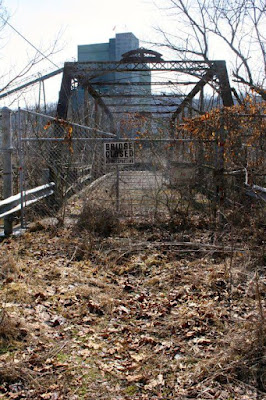 |
| Photo by Pete Zapadka, March 2015. |
One of the oldest iron truss bridges in the United States
is hidden along Route 21 in West Waynesburg. Thousands pass it daily without notice.
Called White’s Ridge Road Bridge, it was constructed over Ten
Mile Creek in 1877 by Massillon (OH) Bridge Company. This county-owned
road and bridge served travelers between Waynesburg and Oak Forest for 100
years until development of Emerald Mine No. 1 in 1975 cut off access to the creek’s
south bank.
 |
| Another view of White's Ridge Road Bridge. Photo by Pete Zapadka. |
The Waynesburg bridge has a younger sibling, Pollocks Mill Bridge,
near Jefferson, built by the same company one year later. In 2014, it was
severely damaged by an overweight water-hauling truck, but has since been
restored to active use.
 |
| Pollocks Mill Bridge near Jefferson. Credit: Swpa Rural Exploration |
The closing of Emerald Mine presents new opportunities to save the Waynesburg bridge. One suggestion is for a bike, equestrian or all-purpose trail. A similar Massillon bridge of 1881 has been restored for pedestrian use in Cuyahoga National Park, Breckville, OH.
Though long abandoned, the White’s Ridge Road Bridge is well known to experts across the country. All have urged its preservation. To quote historicbridges.com: “Any work done on this bridge should be of the highest restoration quality such that the maximum amount of original material is not removed or altered, and anything that is replaced be replaced with an exact replica.”
Though long abandoned, the White’s Ridge Road Bridge is well known to experts across the country. All have urged its preservation. To quote historicbridges.com: “Any work done on this bridge should be of the highest restoration quality such that the maximum amount of original material is not removed or altered, and anything that is replaced be replaced with an exact replica.”
 |
| White's Ridge Road Bridge. Photo by Pete Zapadka. See his post "We Have To Save This Bridge!!!" in the Greene County Pa Time Capsule on facebook. |
Historic bridge expert Todd Wilson, author of “Pittsburgh’s Bridges” (2015), describes the White’s Ridge Road
Bridge as a one-of-a-kind design, reflecting “unusual experimentation at a time when bridge companies competed with
each other in proprietary design.” Before 1900, bridges were specialty
products individually designed and often patented, whereas today all are built to
the same government standards.
 |
| "Waynesburg Prosperous and Beautiful" (1907) published this circa 1902 view of West Waynesburg before the tin mill was erected. The caption is"Ten Mile Valley, Looking West from Sunset Park." |
 |
| Photo enlargement shows location of the bridge at the curve in the creek. |
According to historicbridges.com, the Waynesburg bridge is
“a rare survivor of the iron bridge era, historically
and technologically significant in several areas.” Nationally, there are
only two others with the same hybrid truss configuration, both by the competing
Wrought Iron Bridge Company of Canton, OH. White’s Ridge Road Bridge is the only known example by Massillon.
Truss bridges are composed of connected, load-bearing
elements formed into triangular units. They come in many variations, often
named for the inventor. The Waynesburg bridge design has been described as “bizarre
and unique.” While its diagonals follow the Pratt configuration, the counterweights are Whipple. In Pratt trusses,
vertical members and diagonals slope down toward the center whereas in Whipple
diagonals cross the neighboring vertical rather than connect to it.
| Truss bridge configuration. Wikipedia. |
 |
| Whipple truss configuration. Wikipedia. |
The verticals and diagonals of the Waynesburg bridge are made of wrought iron while the portal is cast
iron. Massillon bridges are known for the beauty of their decorative
ironwork.
 |
| White's Ridge Road Bridge. Photo by Pete Zapadka |
In bridge development, iron was a brief link between traditional
wood or stone and modern steel. The first iron bridge in America was constructed in 1836 over
Dunlap’s Creek in nearby Brownsville. However, its arch design was not
often repeated because it was more difficult and expensive to build than the soon-to-be-developed
truss system. By the 1870s, iron truss bridges were erected on a large scale across
the country, though few remain today.
 |
| Dunlap's Creek Bridge, ca. 1894, before sidewalks were added to its flanks. Still in use today. Credit: "The Old Pike" (1894), courtesy of Pennsylvania Historical and Museum Commission. |